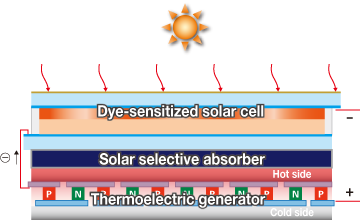Home > Highlighting JAPAN > Highlighting Japan DECEMBER 2012 > Hybrid Solar Cells Harness the Thermoelectric Effect
Highlighting JAPAN
[SERIES] SCIENCE & TECHNOLOGY
Hybrid Solar Cells Harness
the Thermoelectric Effect
Thermoelectric generators convert thermal energy into electric energy. Solar cells do the same using light energy. Researchers in Japan are working to combine the two in an effort to significantly improve the efficiency of photovoltaic power generation. Takashi Sasaki reports on a new initiative aimed at harnessing clean, natural energy.

Diagram showing the cross-sectional structure of the hybrid power generation device developed by Professor Koumoto and his colleagues
Credit: COURTESY OF PROFESSOR KUNIHITO KOUMOTO
"At present, we reuse one third of the thermal energy produced by the manufacturing industry, at most," explains Professor Kunihito Koumoto from the Graduate School of Engineering at Nagoya University. "If we could convert all that waste heat into easily accessible electric energy, it would be a major breakthrough in terms of energy and environmental issues."
In 2007, a thermoelectric material developed by Nagoya University and the Japan Science and Technology Agency (JST) amongst others demonstrated that waste heat generation had the potential to become a commercial reality. The key was to use a common oxide called strontium titanate in place of heavy metals such as bismuth, antimony and lead, which had been used previously in spite of their rarity and high levels of toxicity. By inserting a specially treated 0.4-nanometer ultra-thin strontium titanate sheet between strontium titanate insulators, researchers managed to produce a considerable electromotive force. As well as keeping costs to a minimum, this new thermoelectric material almost doubled conversion efficiency compared to existing thermoelectric generators.

Professor Kunihito Koumoto, Nagoya University Graduate School of Engineering
Credit: TAKASHI SASAKI
"Others had already carried out research based on the idea of combining solar cells with thermoelectric generators, but none of them had managed to produce solid results. The reason for that lies with commercially available silicon solar cells, which absorb the majority of the sunlight they receive rather than letting it pass through the solar panel. With that in mind, we focused on developing a dye-sensitized solar cell that would only absorb the ultraviolet rays and visible light contained in the sunlight shining down on the panel."
Dye-sensitized solar panels enable infrared rays to pass through. Consisting of conductive glass, oxide semiconductors and sensitizing dye, dye-sensitized solar cells have a maximum electromotive efficiency of 12.3%, slightly lower than silicon solar cells. On the flipside however, they can be easily produced at a far lower cost.
The hybrid device developed by Professor Koumoto and his colleagues contains a composite material that absorbs infrared rays and generates heat, sandwiched between a dye-sensitized solar cell on top and a thermoelectric generator directly bonded underneath. This is the first time anywhere in the world that this technique has been used.
The hybrid device currently has an electromotive efficiency of around 14%, due to the fact that it uses existing thermoelectric generators. Simulations however show that a new strontium titanate thermoelectric generator could potentially increase electromotive efficiency to 20% or higher, exceeding the efficiency of regular solar cells by 50%. These new cells also differ from silicon solar cells in that they can also be freely shaped and colored. They are flexible enough to be used for a wide range of purposes, from vehicles to buildings.
"Japan leads the world in the field of thermoelectric generator development. Not many people know about it yet, but work is already underway on commercial ventures to harness heat from waste incinerators and hot springs. Thermoelectric generators will hopefully lead to greater advances in power technology in the future, improving the performance of hybrid power generation devices even further," says Koumoto.
The idea of combining solar cells with thermoelectric generators came from a desire to fully harness energy from the limitless supplies of sunlight that shine down on the earth. This completely new breed of generation system could potentially be the key to creating a solar energy society, an ideal future society free from dependence on fossil fuels and nuclear power.
© 2009 Cabinet Office, Government of Japan






